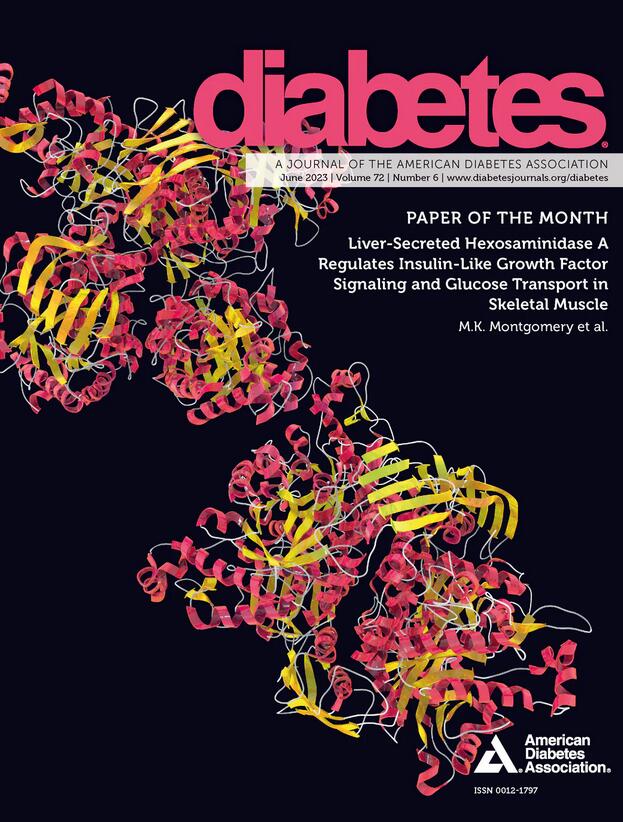1388-P:COVID-19 感染后儿童和年轻人患糖尿病的风险--DiCAYA 研究
IF 6.2
1区 医学
Q1 ENDOCRINOLOGY & METABOLISM
引用次数: 0
摘要
导言& 目的:尽管最近开展了相关研究,但COVID-19感染与糖尿病发病之间的关系仍不明确。我们采用基于多州电子健康记录的监测方法,研究了儿童(<18)和年轻成人(18-44)感染 COVID-19 后新发糖尿病的风险。研究方法进行汇总固定效应荟萃分析。对2018-2019年接受治疗的无糖尿病证据的患者(n=5,412,604)进行随访,直至确诊糖尿病、死亡或随访结束(12/31/22)。COVID-19 感染的定义采用 6/1/20-12/31/21 期间的化验或诊断结果。病例的个人时间从感染日期开始计算,对照组的个人时间从随机选择的就诊日期开始计算。在每个地点分别运行倾向得分加权 Cox 回归模型,以估算儿童和年轻成人糖尿病风险的危险比 (HR)。结果:与没有感染记录的人相比,接触过 COVID 的人患糖尿病的风险更高(儿童 HR = 1.85 [1.69, 2.03];青少年 HR = 1.37 [1.31, 1.42])。所有参与研究的机构都报告了风险升高的情况,但年轻成人的结果差异较大(范围 1.3-3.7,异质性 I2=94% vs. 范围 1.6-2.0,I2=0%,图 1)。结论这些初步研究结果表明,COVID-19 感染与儿童和青壮年糖尿病发病风险增加有关。披露 S. Conderino:无。H. Kirchner:无:无。L. Thorpe: None.J. Divers:J. Divers: None.A.G. Hirsch:无。C.M. Nordberg:无:无。B.S. Schwartz:无。B. Cai:无。C. Rudisill:无。J.S. Obeid:无。A.D. Liese:无。B.E. Dixon:其他关系;Elsevier.D. Dabelea:无。A. Bellatorre:无。H. Shao:顾问;礼来公司。J. Bian:无。Y. Guo:无。K. Reynolds:研究支持;默克夏普公司(Merck Sharp & Dohme Corp.M.T. Mefford:默克公司:研究支持M.K. Kamboj:无。E.A. Mendonca:无。K. Allen:无。S. Burgett: None.E. Lustigova: None.S. Bost:S. Bost: None.M. Maltenfort:M. Maltenfort: None.L.H. Utidjian:无。M.M. Zhou:无。T.L. Crume:无。A. Titus:无。本文章由计算机程序翻译,如有差异,请以英文原文为准。
1388-P: Risk of Diabetes among Children and Young Adults after COVID-19 Infection—The DiCAYA Study
Introduction & Objective: The association between COVID-19 infection and incident diabetes remains unclear despite recent research. Using a multistate electronic health record-based surveillance approach, we examined the risk of new diabetes among children (<18) and young adults (18-44) post COVID-19 infection. Methods: Pooled fixed-effects meta-analyses were performed. Patients (n=5,412,604) with no evidence of diabetes who received care in 2018-2019 were followed through diabetes diagnosis, death, or end of follow-up (12/31/22). COVID-19 infection was defined using labs or diagnoses from 6/1/20-12/31/21. Person-time was calculated from infection date for cases or a randomly selected visit date for controls. Propensity score-weighted Cox regression models were run at each site individually to estimate hazard ratios (HR) for diabetes risk for children and young adults. Results: COVID-exposed individuals were at higher risk of incident diabetes compared to those with no documented infection (Children HR = 1.85 [1.69, 2.03]; Young Adult HR = 1.37 [1.31, 1.42]). All participating sites reported elevated risk but results were more heterogeneous across young adults (range 1.3-3.7, heterogeneity I2=94% vs. range 1.6-2.0, I2=0%, Figure 1). Conclusion: These preliminary findings suggest COVID-19 infection is associated with increased risk of incident diabetes among children and young adults. Disclosure S. Conderino: None. H. Kirchner: None. L. Thorpe: None. J. Divers: None. A.G. Hirsch: None. C.M. Nordberg: None. B.S. Schwartz: None. B. Cai: None. C. Rudisill: None. J.S. Obeid: None. A.D. Liese: None. B.E. Dixon: Other Relationship; Elsevier. D. Dabelea: None. A. Bellatorre: None. H. Shao: Consultant; Eli Lilly and Company. J. Bian: None. Y. Guo: None. K. Reynolds: Research Support; Merck Sharp & Dohme Corp. M.T. Mefford: Research Support; Merck & Co., Inc. M.K. Kamboj: None. E.A. Mendonca: None. K. Allen: None. S. Burgett: None. E. Lustigova: None. S. Bost: None. M. Maltenfort: None. L.H. Utidjian: None. M.M. Zhou: None. T.L. Crume: None. A. Titus: None.
求助全文
通过发布文献求助,成功后即可免费获取论文全文。
去求助
来源期刊

Diabetes
医学-内分泌学与代谢
CiteScore
12.50
自引率
2.60%
发文量
1968
审稿时长
1 months
期刊介绍:
Diabetes is a scientific journal that publishes original research exploring the physiological and pathophysiological aspects of diabetes mellitus. We encourage submissions of manuscripts pertaining to laboratory, animal, or human research, covering a wide range of topics. Our primary focus is on investigative reports investigating various aspects such as the development and progression of diabetes, along with its associated complications. We also welcome studies delving into normal and pathological pancreatic islet function and intermediary metabolism, as well as exploring the mechanisms of drug and hormone action from a pharmacological perspective. Additionally, we encourage submissions that delve into the biochemical and molecular aspects of both normal and abnormal biological processes.
However, it is important to note that we do not publish studies relating to diabetes education or the application of accepted therapeutic and diagnostic approaches to patients with diabetes mellitus. Our aim is to provide a platform for research that contributes to advancing our understanding of the underlying mechanisms and processes of diabetes.
 求助内容:
求助内容: 应助结果提醒方式:
应助结果提醒方式:


